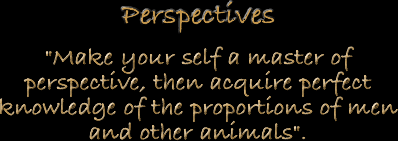
Leonardo was able to create realistic paintings because he was an expert in perspective and use of shadows to create 3-D images on flat surfaces. Using the various sketches that Leonardo made prior to his painting, the "Adoration of the Magi", students will investigate how perspective is altered depending on where the viewer was standing.

Adoration of the Magi - sketch
Once students understand the underlying theories of perspective, students will compose their own sketches of items viewed from different positions within the classroom. Students will also have the opportunity to do this exercise using a digital camera, and relate their sketches to the digital images, both on a 2-D plane).
This project is intended as the introduction project of the unit as it will allow students to develop skills that will be required for following projects. In the project The Vitruvian Man students will use their new skills in dealing with perspective to successful position their subjects to acquire the needed images. They will also have created the understandings needed to build on for one point perspective needed for the project The Last Supper, and for understanding how to estimate heights of objects and distance based on where you are in relation to the object in the Trees and Forests project.

Adoration of the Magi - final product